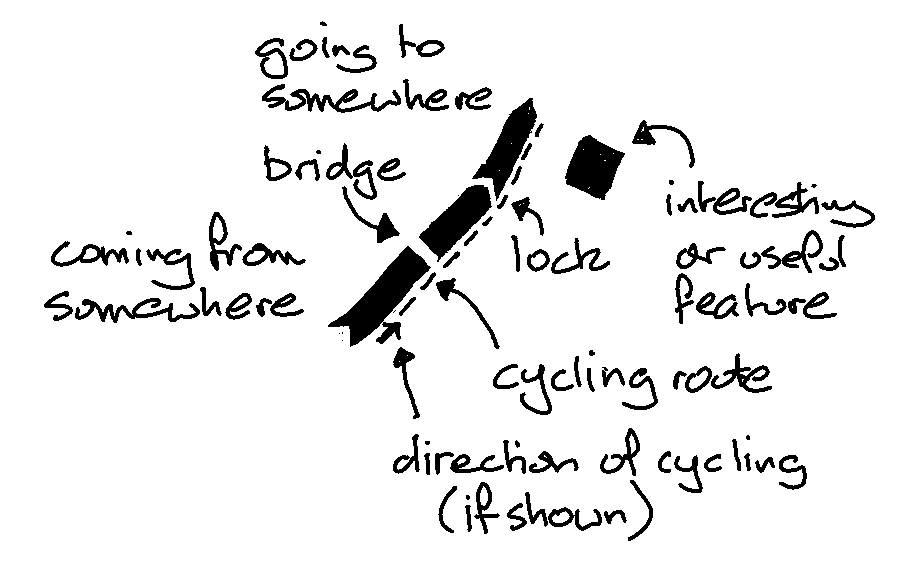Continuity of Rides
My aim is that rides should join up with each other to form a complete set of rides covering all the ride-able canal towpaths in the UK. Sometimes this involves doing a short extra stretch to meet up with an adjacent ride – this is usually explained.
Adjacent rides are listed in the introductory section of each ride – if there is not a clickable link, the ride has not yet been completed. If there is a question mark, I haven’t fully thought it through yet – planning rides takes twice as long as doing them!
Difficulty Ratings
EASY – good towpaths, often metalled, no hills, difficult sections or “carries”. Navigable with any type of bike. Good for kids.
FAIR – generally as “EASY”, with a few more testing sections, or a few easy steps.
MODERATE – at least half the ride is EASY or FAIR. Some bumpy, sloping, narrow or muddy sections, some hills and/or gates.
HARD – Significant bumpy, narrow sections, with sloping towpaths, breaches or overgrown foliage. Steep hills, gates and/or stiles for significant parts.
Please don’t ever think I’m complaining when I say conditions are difficult, or towpaths unmaintained. If you look at old photos of how canals fell into disrepair you will realise what a fabulous restoration job has been done to date, and more is happening all the time.
Types of Cycle
Mountain or hybrid cycles are recommended. Rides categorised as EASY are suitable for all types, including electric bikes. Don’t attempt MODERATE or HARD rides on an electric bike unless you can easily lift it, as there will be sections where you need to lift/carry your cycle.
Towpath Surface
METALLED – tarmacked, paved, or other good quality hard surface suitable for all cycles.
COMPACTED EARTH & GRAVEL – a prepared standard footpath, with a reasonable surface. May have loose gravel, and puddles when wet.
EARTH & GRASS – a trodden path with no prepared surface.
GRASS – no path to speak of, just a mown or unmown stretch of greenery, usually bumpy with nettles, brambles, etc.
Mileages and Speeds
The mileages and speeds shown are my own cycling time as recorded on Strava. Just to give you a heads up and something to compare to – you may be faster or slower than me!
Remember: 1 mile on a towpath is equivalent to 2 miles on the road. As my cycling mate Jason calls them: “canal miles”!
Distance Measurements
I have used miles to indicate ride/section and other significant distances, and metres to indicate shorter distances (similar to how it is done on road signs). Sometimes I forget and use feet!
Types of Ride
SOLO – you can do these rides on your own, usually cycling one way, and taking the train back (or vice-versa). On a few solo rides you have to backtrack on yourself to the start point – described as a “there and back” ride. I try to avoid doing this wherever possible.
CIRCULAR – a solo ride that starts and finishes at the same point, without using a train, and without backtracking. Usually involves a small section of road travel.
2 CAR – for these rides you will need to park a car at each end of the ride as there are no suitable train stations.
Trains
The development of our industrial history (industrial towns firstly connected by canals, then by rail) means that railways frequently follow similar paths to canals, which makes it relatively easy to get back to your start point without backtracking in many cases.
The single standard fare is quoted for each ride, as of the date I did the ride. Use a railcard, and travel off-peak, to get the best prices.
Most operators take cycles without booking, especially off-peak, but it’s worth checking beforehand. Avanti and Great Western are particularly awkward about it. Where booking is required it will say so in my notes. As far as I know, wherever cycles are permitted, they travel for free.
Key to My Maps

Nicholson Guides
The Nicholson Guides are the very useful guides to the UK canal network that every boater has tucked inside their cabin. They not only provide navigational notes for boaters, but also lots of useful information about the area being passed through including, crucially, pubs and shops. However, although there are brief general descriptions of cycling conditions, and other rides in the area, they don’t go into detail about towpath cycling conditions as I do.
For each ride I have provided the Guide number, and relevant page numbers. Each guide is updated and republished every few years. Note that when a new edition is published, some page numbers may change, and I might not always be completely up to date!
If you are going to spend time cycling a particular part of the network, I would recommend buying the relevant Guide for around £15 – it will give you a wealth of background to the canals you’re cycling.
There are a few rides I have done that are not listed in Nicholson – these are indicated in the notes.